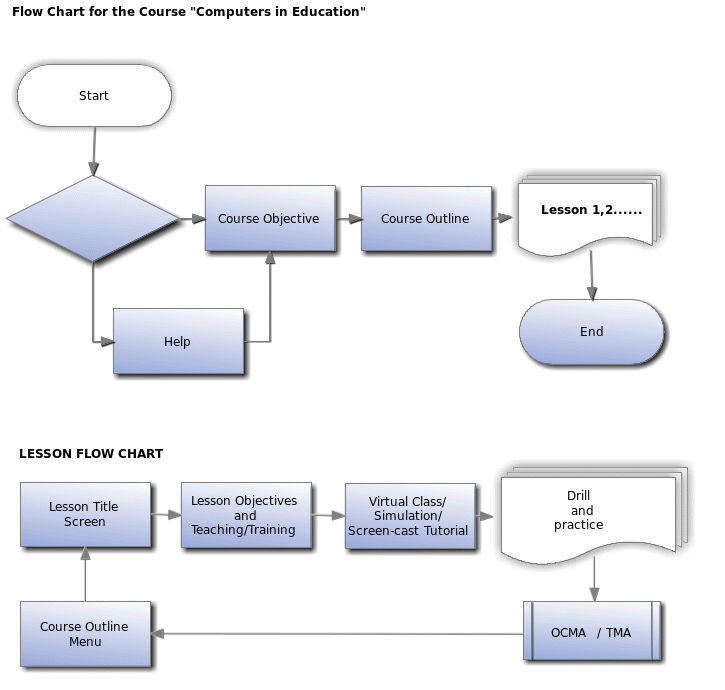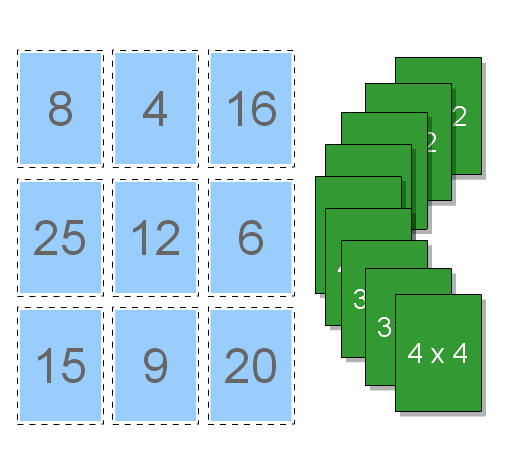Methods of Assessment
This study develops a computer mediated module in project assessment, utilizing several design techniques to enrich the learning experience.
The computer-mediated learning module will be used via a handheld device or through a computer, which will represent content in linear fashion (not very different from how people read online publications).
Static processes will be mainly taught using this process and softwares will be an important tool for undertaking respective tasks; however, it should be noted that, the difference between this computer mediated learning process and the web based learning model is very small, but the latter uses the internet, while the former uses CD ROMs (and such like data transfer mechanisms).
This module is designed in a manner that does not involve any internet usage.
Since this module is computer based; assessments will be done through multiple choice questions where students will answer respective questions related to the module and the computer will easily perform the task of assessment (through softwares) without any external input.
A drag and drop structure, radial button, simulation and other interactive means, will be used as complementary assessment tools, to be undertaken electronically, and the feedback communicated to the user, almost immediately.
However, the major assessment criterion to be used will be the formative assessment test which works by sifting through several incorrect answers to come up with the right answer, as an evaluative criterion. This strategy will be used to assess what the students have learnt (or not learnt) regarding project management.
To enhance the students’ understanding under the module, the instructor will explain how each question should be approached, to give the student an understanding of the practice to be studied (with every variation evidenced when sifting out the questions).
This first part of assessment encompasses the formative stage, but the second part is the summative assessment stage, where an assessment will be done to evaluate only the topics that were taught.
After the second assessment, the data will be reported to the students in several ways. For example, different formats will be used to communicate the students’ scores, and this will include percentages, marks and grades. Multiple scores and grades will also be used to communicate different aspects of the student’s performances, through a remote out-of service application.
A runtime data model will be used to encode the information received into a standard format of programming (BASIC), and a standard metadata will also be used to identify a particular activity in the performance criterion which will articulate the performance data to be sent back to the student.
However, before the feedback is communicated to the students, alpha and beta testing will have to be carried out; both at the developer’s sight and at the end user computer. Alpha testing will be used for application evaluation softwares, but beta testing will be adopted after the assessment results are assessed by another independent party (which in this case would be the administration).
In the beta testing stage, the instructor will have no control over the evaluation process, and feedback will be communicated to the students regarding their performance. This will be a way to ensure the systems credibility is in check.
Instructional Strategies
The primary instructional strategy to be used will be the case-based learning strategy. This strategy will be used to solve learning dilemmas which can be best solved by analyzing previously existing cases. The case-based learning strategy will be used to induce meaningful discussions among students about real world examples that the computer-aided model may fail to expose (Herreid, 1997, p. 163).
The inducement for discussion is one advantage of this technique because its superiority emanates from the fact that, the strategy is learner-centered.
The approach will therefore enable students build a huge body of knowledge, without much input from the instructor because the instructor’s role will be reduced to that of a facilitator only. Since the teaching methodology is computer-mediated, such a learning strategy is very practical because students can easily undertake meaningful discussions through computer-aided techniques.
This approach will be undertaken alongside the simulation technique to replicate real life examples in the computer environment (Sokolowski and Banks, 2009, p. 6). Inhibitive or impossible learning styles which are difficult to explain in the real world environment will therefore be easily explained in the computer environment.
In using the simulation technique, various softwares will be used, including the Monte calo simulation software and the stochastic modeling technique; these softwares will enable the simulation process become almost effortless (Sokolowski and Banks, 2009, p. 6).
This approach is also useful to the learning process because it allows for student mistakes, without necessarily having to suffer the implications of such mistakes in the real life environment (Sokolowski and Banks, 2009, p. 6). This platform therefore allows for a speedy correction of student mistakes before they can be experienced in the real life environment (Sokolowski and Banks, 2009, p. 6).
The cognitive tools to be used will be a combination of chunking and graphic organizers. Both strategies will be used to “increase the student’s ability to recall what was taught, increase student understanding, eliminate boredom and organize student thoughts” (Sokolowski and Banks, 2009, p. 6). Graphic organizers as a cognitive tool will take many forms, including concept mapping flow charts, webbing and matrix structures.
Webbing will specifically entail brainstorming as the core activity and for comparison purposes; the double cell diagram will be used. As the name suggests, the concept mapping strategy will use the concept map in comparing or contrasting.
The comparison matrix will be used to compare the attributes and characteristics of the subjects or topics of discussion to establish which learning item share the same qualities and which ones have different qualities. This cognitive tool will complement the goal of the case-study approach because it is also analytical in nature and it can be used to describe specific attributes of an object without making conclusions about it.
In other words, it makes the process of analysis very simple. The comparison matrix will also be used a visual aid, and in this regard, students are likely to develop deep analytical skills, and in the same regard, the cognitive tool can be used to analyze different objects at the same time.
The flowchart will be the last cognitive tool to be used and it will be used to represent learning contents in folders and subfolders, which are linked by the subordinate relationships they share. The flow chart will be used to analyze, collect and distribute information. The following example represents it:

Source: Ali Baig (2010)
Learner Activities
There are several learning activities that will be used to make the learning experience more enriching to the students. However, these learning activities will be specific to the learning stage or task in question. The first task in the learning process is remembering facts which were taught through the primary instructional strategies identified above.
In ensuring students effectively remember such facts, performance aids will be the primary activity to be adopted (Clark, 2004). Performance aids will be used by the students to describe the tasks they have learnt in an electronic manner, through a software which will give instant feedback regarding the student’s performance.
This process will therefore be done in an electronic performance support system, which unlike the conventional type, does not need to be subjected to printing, shipping or mailing to assess the student’s performance in the learning activity. Results will be availed instantly.
Other traditional learning activities will also be incorporated into the learning module and first among them is the questioning session where students will be asked questions by their colleagues (and the instructor) about what they have been taught (Clark, 2004). This will be done in a real-time forum which resembles a debate, where participants answer questions in front of their colleagues and are given scores immediately.
The design of this interactive session will be in a group format where students will be clustered in various groups and assigned several random questions that they will be supposed to answer within a specified time period. Scores will be availed immediately and the right answers availed to groups with the lowest scores.
The second stage in the learning process to be analyzed will be the understanding of important concepts of study. In this stage, students will be required to draw computer-aided animations to represent certain concepts of study. Such animations will be accompanied by explanatory texts. A drag and drop exercise will also be incorporated in the study module to analyze the student’s comprehension abilities (Clark, 2004).
For example, questions will be categorized under one category of boxes and answers will be categorized in another. Students will therefore be required to match the right boxes, with questions that resemble the right answers. The following diagram shows an example:

Source: Clark (2004)
This strategy will also be used in the application phase of the learning process, but a demonstration exercise will also be introduced to expose how well students have understood the learnt concepts by demonstrating they understand all required processes to make a system complete.
The next group of learning activities will be aimed at ensuring students have mastered the right analytical skills; say, by troubleshooting a given problem and determining the right course of action to be undertaken.
Computer aided discussions will be encouraged as the primary learning activity which allow students to create, modify or distribute the contents learnt to solve specific dilemmas regarding various learning problems (Clark, 2004). This will be an interactive exercise among students.
In this context, file sharing becomes an important concept of information exercise among students because certain medium such as “flickr” and “slide share” will be used (Clark, 2004). As the second learning activity in this category, charts and matrix structures will also be used to evaluate the student’s analytical skills because here, students will be required to draw several steps regarding the various processes analyzed.
References
Ali Baig, M. (2010). Syllabus for Computers in Education. New York: Vclassroom.
Clark, D. R. (2004), Instructional System Design Concept Map. Web.
Herreid, C. (1997). What Makes a Good Case? Some Basic Rules of Good Storytelling Help Teachers Generate Student Excitement in the Classroom. Journal of College Science Teaching, 12, 163-165.
Sokolowski, J.A. & Banks, C.M. (2009). Principles of Modeling and Simulation. Hoboken, NJ: Wiley.